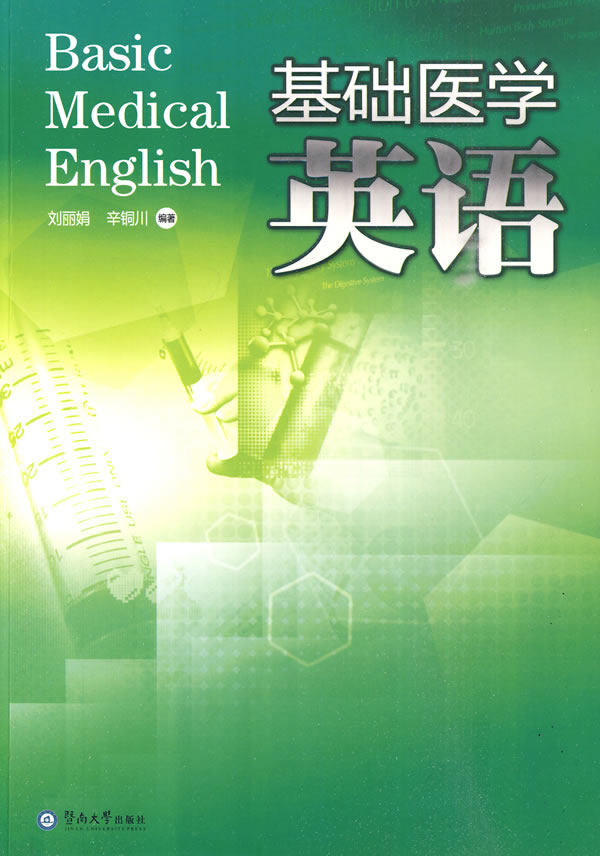- ISBN:9787811354638
- 装帧:暂无
- 册数:暂无
- 重量:暂无
- 开本:16开
- 页数:156
- 出版时间:2010-01-01
- 条形码:9787811354638 ; 978-7-81135-463-8
内容简介
this book, developed from teaching experience, has several features that distinguish it from other textbooks in that a comprehensive introduction to the formation of medical terminology, and various examples and supporting exercises that are practical and helpful, are provided for both the instructor and the student.
chapter one introduces briefly the etiology of english language and that of medical english. chapter two and three provide a foundation for the formation of medical terminology. chapter four through fifteen present special medical terms related to body systems. each chapter begins with a short brief passage, acting as a platform for the entry of a certain body system, mainly the introduction to the structure and function of this body system.
目录
chapter one a brief introduction to medical terminology
chapter two formation of medical terminology (i)
chapter three formation of medical terminology (ii)
chapter four pronunciation and plural forms of medical terms
chapter five human body structure
chapter six the integumentary system
chapter seven the museuloskeletal system
chapter eight the cardiovascular system
chapter nine the respiratory system
chapter ten the digestive system
chapter eleven the nervous system
chapter twelve the urinaary and male reproductive system
chapter thirteen the female reproductive system and obstetrics
chapter fourteen the endocrine system
chapter fifteen the blood and lymphatic system
index
bibliography
节选
《基础医学英语》内容简介:In the 15 years of teaching medical English I have frequently felt the pressing need for an appropriate textbook, either practical and effective in a classroom setting or helpful as a self-taughttool for a motivated student with little or no supervision. Sponsored two years ago by the TeachingAffairs Department of Jinan University, the textbook "Basic Medical English" has finally comeinto being, with its mission to provide the basics of medical language for medical students.This book, developed from teaching experience, has several features that distinguish it fromother textbooks in that a comprehensive introduction to the formation of medical terminology, andvarious examples and supporting exercises that are practical and helpful, are provided for both theinstructor and the student.
相关资料
插图:The cell is enclosed in a membrane which regulates and controls the entry'and exit of substances to and from the cell. Within the nucleus are contained 23 pairs of chromo-somes, the slender threads composed of still smaller units called genes. There are 46 chromosomes(23 pairs) in all human cells, with the exception of mature sex cells, which only have half thisnumber (23). Chromosomes and genes are composed mostly of a compound named deoxyribonu-cleic acid that is always referred to as DNA. DNA makes heredity possible and is therefore alsoreferred to as the heredity molecule. The genes are responsible for "coding" the inherited traits ofeach cell and therefore of each human being. All cells are contained in the building material calledprotoplasm, a substance that looks much like the white of an egg.A tissue is a group of similar cells working together to do a specific job. The basic types of tis-sues include : epithelial tissue located all over the body, forms the linings of internal organs, andthe outer surface of the skin covering the body. It also lines exocrine and endocrine glands. Themain functions of epithelial tissue are to protect, absorb, and secrete. Muscle tissue is composedof cells that is capable of contracting (shortening) and relaxing (lengthening), usually producingmovement, enabling you to run, do some physical labor, blink your eyes, swallow your food——anything that involves movement. Skeletal, smooth, and. cardiac are the three types of muscletissue. The main function of muscle tissue is to contract. ~luscle cells are long and slender and arecalled fibers. The fibers decrease in length and increase in thickness during contraction of a mus-cle. Connective tissue is the most abundant and most widely distributed type of tissue. It connects,supports, penetrates, and encases kvarious body structures. There are two types of connectivetissues: solid and fluid.
-

地心游记(纯英文)/床头灯英语.3000词读物
¥5.4¥15.8 -

茶花女
¥4.2¥12.0 -

流浪地球刘慈欣
¥21.1¥62.0 -

小妇人(纯英文)/床头灯英语.3000词读物
¥4.7¥15.8 -

了不起的盖茨比(纯英文)/床头灯英语.3000词读物
¥4.5¥12.8 -

本杰明:富兰克林自传
¥4.7¥13.5 -

THE GREAT GATSBY-了不起的盖茨比
¥6.9¥16.8 -

Sons and Lovers
¥7.8¥26.0 -

方法论
¥3.9¥9.5 -

写给儿童看的英语:情境联想600句(英汉对照)
¥17.1¥39.8 -

最新英汉百科图解词典-升级版
¥104.2¥168.0 -

命案目睹记
¥21.7¥33.8 -

沉思录
¥10.5¥21.0 -

巴黎圣母院
¥4.7¥15.5 -

英诗选译-孙大雨译文集-(英汉对照)
¥12.2¥36.0 -

莎士比亚四大悲剧(世界文学名著英文版)
¥12.2¥32.0 -

城堡
¥13.0¥26.0 -

查拉图斯特拉加是说
¥14.5¥29.0 -

飞鸟集(泰戈尔英汉双语诗集)
¥9.5¥11.9 -

无英语词根与单词的说文解字(新版)(2020)
¥52.7¥65.9













